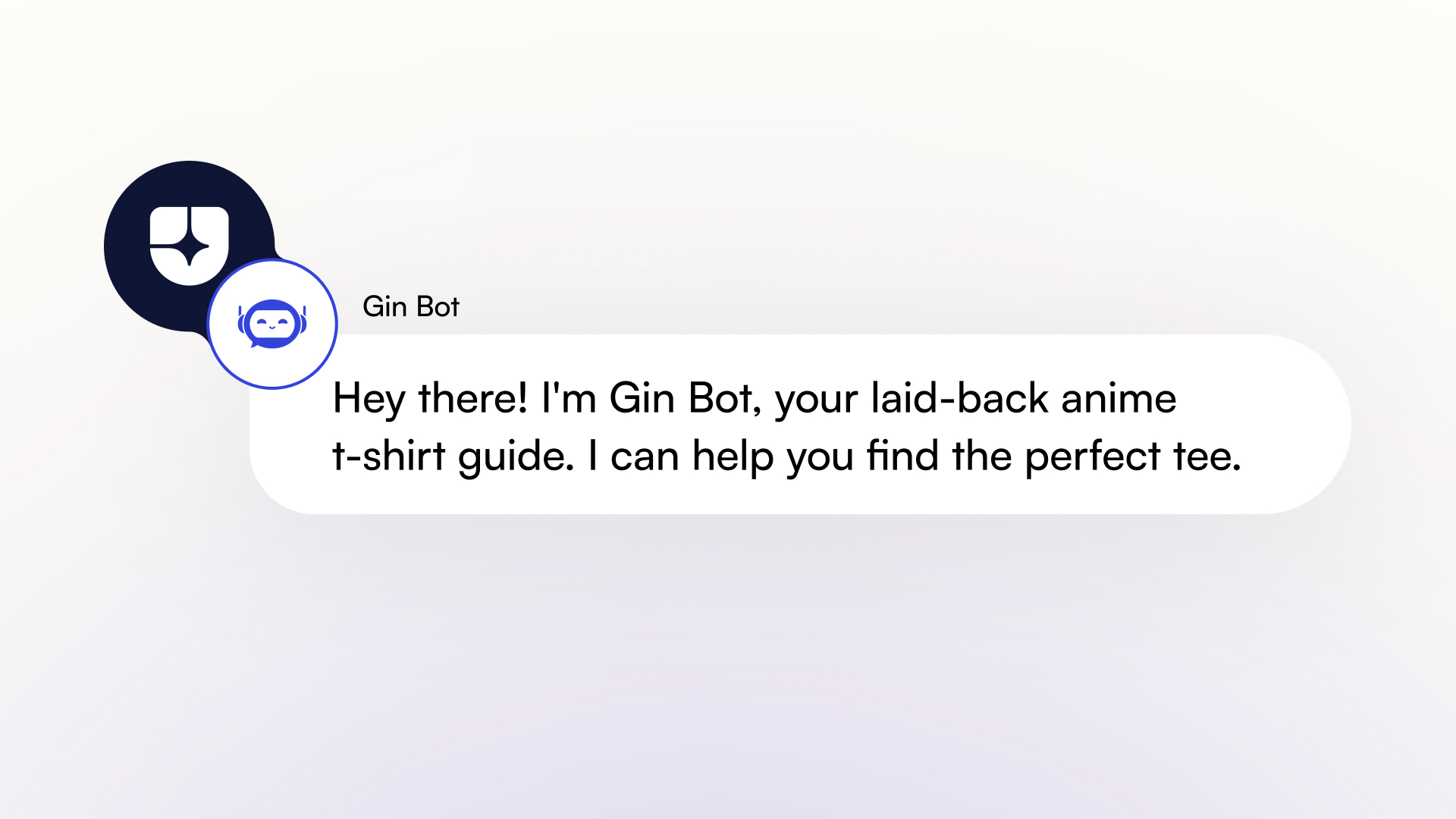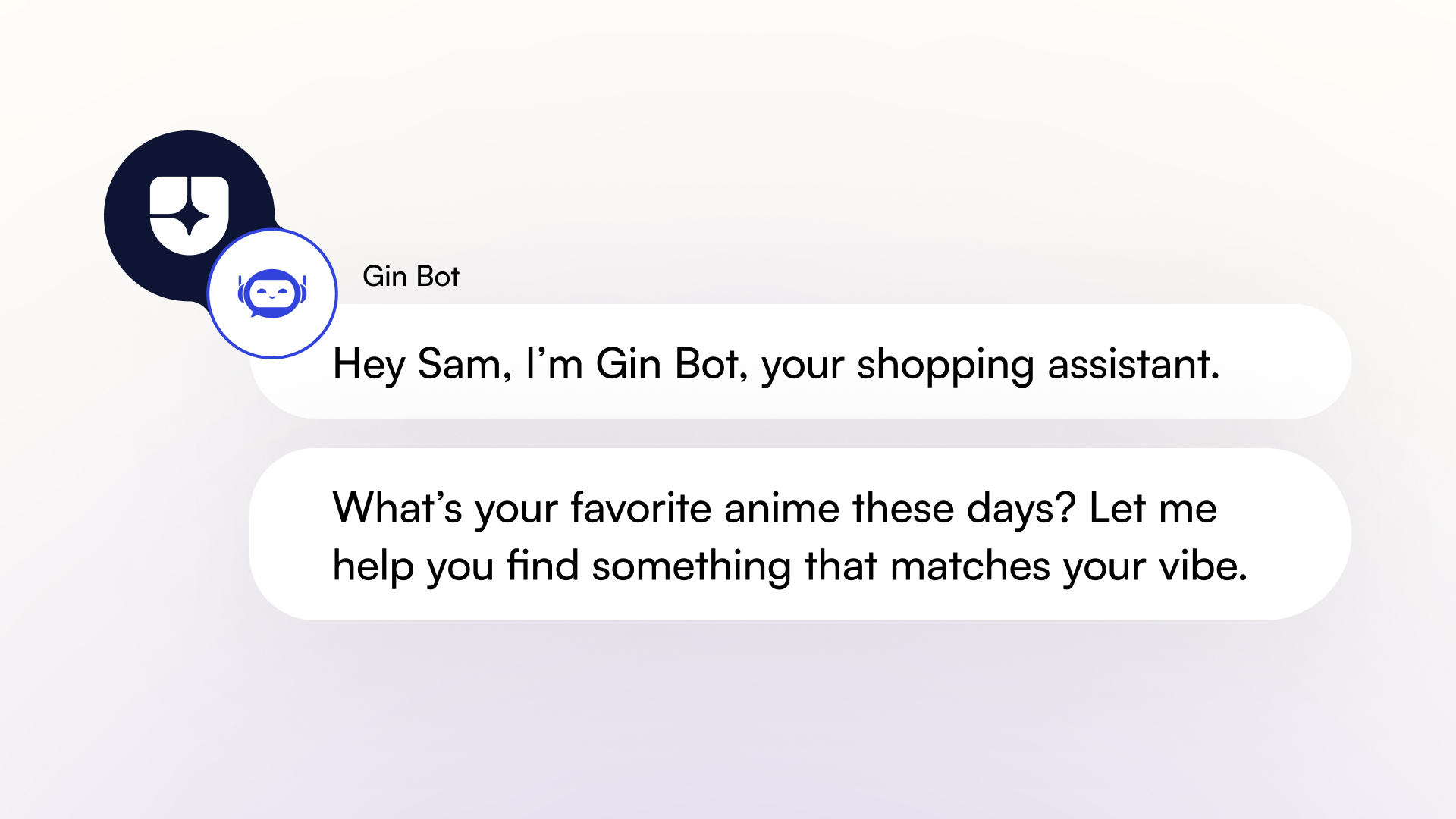Perfecting Your Chatbot Welcome Message: 45+ Applicable Examples

Kasturi Goswami
September 20, 2024
13 min

Table of Contents
Initial experience is what speaks for the entirety of a brand’s life. Though some might like to disagree, with the changing pace of consumerism, it is safe to say that, if not all, trust building is vital from the first contact.
The first impression decides whether a customer stays or leaves - sometimes, it takes seconds. For small to medium-sized businesses, that reality plays out daily.
Chatbots are becoming integral in a business’ marketing game and are increasingly used as the first POC with their customers. Conversational marketing chatbots are at the forefront of this shift. According to a survey, micro and small businesses are leading the early adoption trend and are willing to go further and dip their fingers into the game. (Tidio)
SMBs like yours are on a tight lease with fewer employees and a need to boost revenue streams. Efficiency is everything for you. The first interaction with your custom ai chatbot can either pique interest or lead to a bounce
Here, chatbot welcome messages come in—a seemingly small aspect, yet one that can have a massive impact on engagement, retention, and, ultimately, your revenue.
What are Chatbot Welcome Messages?
The first response your chatbot produces when interacting with your visitor is the chatbot welcome message. This is when the user taps the “Get Started” button or when a returning customer begins a chat.
It can comprise a mix and match of combinations of different formats depending on your channel, including text, buttons, emojis, images, GIFs, or videos.
Why is it Essential to Create a Good Chatbot Welcome Message?
Maisy is a super mom on a mission - finding the most comfortable eco-friendly diapers for her newborn. In search of answers, she stumbles onto your website. You, EcoMoms, are building a small team-run business that manufactures eco-friendly baby products–including wipes and diapers. Now, let us consider two chatbot interactions.

The first message is impersonal and results in a dull experience, failing to retain Maisy’s attention. She might even consider opting out completely.
The second message is engaging and retains Maisy. It has a trustworthy vibe and offers personalized assistance–a short question relay will lead to Maisy’s product. The use of a casual tone, an emoji, and a proper chatbot name adds to the appeal. It is easier for Maisy to learn about your eco-friendly diapers, and maybe she would buy the wipes, too.
With the convenient and comfortable experience, Maisy will bring other moms and moms-to-be to your website. That is how you turn a visitor into a potential customer.
A good first message sets the tone and flow of the conversation with a visitor to its conversion into a customer.
What is the Main Purpose of a Chatbot Welcome Message?
Greeting to make them feel welcomed
- Warm and inviting: "Hey, [Customer's Name]! Welcome to [Your Brand], where your search for cool finds just got easier. What can I help you with today?"
- Personalized: "Hi [Customer's Name]! 👋 It’s great to have you at [Your Brand]. I am [Your Bot's Name], your personal guide to our best offers. Ready to explore?"
- Friendly and casual: "Yo, [Customer's Name]! 🎉 Welcome to [Your Brand]. Kick back, relax, and let me know if you need help finding something awesome!"
- Enthusiastic: "Woohoo, you're here! 🎉 I'm [Your Bot's Name], your friendly assistant at [Your Brand]. How can I make today amazing for you?"
Pushing interaction
- Direct and clear: "Hi there, [Customer's Name]! 👋 Let's make this easy. Need help with something specific? Or want me to show you around?"
- Curious and engaging: "Hey [Customer's Name], what brings you here today? Whether you're searching for something or just exploring, I’m here to help. Let's dive in!"
- Friendly and helpful: "Looking for something in particular? I’m [Your Bot's Name], and I’m here to guide you. Don’t hesitate, let’s make shopping fun!"
- Encouraging and supportive: "Welcome, [Customer's Name]! I can see you're browsing. Need some suggestions or just want to chat about what’s hot? Ask away!"
Directing visitors to resources
- Clear and concise: "Hi [Customer's Name]! Need a little guidance? Here are some quick links to help you find what you’re looking for: [Link1], [Link2], [Link3]. Let me know if you need more help."
- Personalized: "Welcome back, [Customer's Name]! Based on your recent interest in [Product], here are a few resources that might interest you: [Link1], [Link2], [Link3]. Anything else I can assist with?"
- Friendly and inviting: "Looking to explore? Here’s where the fun begins: [Link1], [Link2], [Link3]. Let me know what piques your interest!"
- Encouraging and supportive: "Lost? No worries, I’ve got your back. Check these out: [Link1], [Link2], [Link3]. If you need more, just ask!"
Informing about promotions
- Direct and exciting: "Guess what, [Customer's Name]? Today’s your lucky day! 🎉 Enjoy 20% off everything in-store. Tap below to start shopping now!"
- Personalized: "Hi [Customer's Name]! 🎉 We’ve got an exclusive 20% discount just for you. Let me know what you need, and I’ll point you in the right direction!"
- Friendly and inviting: "Psst… [Customer's Name], want to score 20% off today? 🎉 Let's get you started on something awesome. Ready to save?"
- Enthusiastic and urgent: "Hey [Customer's Name], time’s ticking! ⏳ Our 20% off deal ends soon. Shop now and grab your favorite items before they’re gone!"
Identifying prospect’s needs
- Direct and clear: "Hi [Customer's Name], what brings you here today? Are you after something specific, or just browsing?"
- Curious and engaging: "Hey [Customer's Name]! 👋 Curious to know, are you looking for something particular or just exploring our latest arrivals?"
- Friendly and inviting: "Hello [Customer's Name], what can I help you with today? Got something specific in mind, or need suggestions?"
- Encouraging and supportive: "I noticed you’re checking out [Product Category], [Customer's Name]. Any special features you’re interested in? Let me help you find the perfect match!"
- Also read: Effective thank you for your patience messages
How to Create the Perfect Irresistible Chatbot Welcome Message
A chatbot’s greeting is about striking a balance between being conversational and offering value immediately. Here’s what you should consider:
Be transparent
While creating your chatbot welcome message, make it clear to the visitors from the get-go that they are chatting with a bot, not a human. You risk losing trust if you lie when they realize they are not talking with a live agent. In states like California, it is illegal for bots to impersonate humans. Doing so could lead to legal consequences. (The Bolstering Online Transparency (BOT) Act)
Your bot can be allotted a persona consistent with your brand but must be transparent about being a bot and not a live person. To ensure this, maybe an avatar can be used along with a self-explanatory name.
Example:
"Hi, I’m [Your Bot's Name]. Just so you know, I’m here to help with anything you need—whether that’s finding a product or answering questions."
Instead of just informing the user, the bot builds trust by clearly stating its purpose in a friendly, open manner.
Consider a situation where you are a licensed anime t-shirt seller. You are a niche product seller aimed at hardcore anime lovers. Say you have decided on a chatbot to make the shopping experience more vibrant and exciting.
Upon visiting the website, customers are prompted with a basic “Your Name” for the first time. The website and chatbot are then accessible and open to conversation.
Chatbot Name: Gin Bot (influenced by the anime character Gintoki Sakata).
Chatbot Persona: A laid-back, sarcastic, and often humorous anime fan who loves t-shirts. He is always up for a good joke and a casual conversation.
Example Greeting: "Yo, what's up? You looking for some sweet anime tees? Let's get you sorted!"
Let us improve this example greeting by applying proven rules for crafting an effective chatbot welcome message. You will find an improved version at the end of each rule.
Improved Greeting:

Match tone and language with your brand personality
For small businesses, your brand is deeply personal. The tone of your chatbot welcome message should reflect that. If your brand is playful, your bot should be too. You can play with emojis and other rich content. If you’re more formal, keep it professional but friendly. Whatever the brand personality your chatbot assumes, remember the three golden rules:
1. Use simple language - clear and persuasive.
2. Do not spam.
3. Give chances to opt out of receiving messages.
For instance:
- Professional and formal: "Good day, [Customer's Name]. How may I assist you with our services today?"
- Casual and friendly: "Hey [Customer's Name]! Ready to find something cool? Let’s get started."
- Enthusiastic and energetic: "Welcome [Customer's Name]! 🎉 I’m so pumped to help you. What are you looking for?"
- Direct and to the point: "Hi [Customer's Name], welcome to [Brand]! Need assistance? I’m here to help."
The tone is seamlessly adjusted to the brand personality, helping to create a personalized, on-brand experience.
Improved Greeting:

Be brief and calculative
The shorter your messages are, the less cumbersome it is for your visitor to understand and achieve their goals.
A good practice is to limit welcome messages to a maximum of 2-3 sentences, and if there are more, split them up into separate bubbles to give the illusion of less text to read. You will risk losing their interest in chatting if you have a long welcome message.
Additionally, you should also decide on the message delay. If the bot replies are too fast, users might be unable to read them. To avoid that, testers can be used to verify which pace is optimal for reading.
Example:
“Hey [Customer’s Name], need help? Let’s get started—just ask away!”
The message remains concise but encourages quick action in a friendly and helpful tone, keeping engagement high.
Improved Greeting:

Personalize without overdoing it
You don’t want to come off as creepy or overly familiar. But at the same time, addressing someone by their first name or acknowledging their browsing history can go a long way. It shows that you’re paying attention, without feeling intrusive.
Research found that 80% of consumers are more likely to make a purchase when brands offer personalized experiences.
Employ chatbot conditional logic to create specific replies for different user segments. For example, differentiate between first-time visitors and returning customers, users from various locations or websites, and those accessing your page through unique URLs.
Try something like this:
For first-timers:
“Hey [Customer’s Name], welcome to [Your Brand]! I’m [Bot’s Name], here to assist you in finding what you need.”
For returnees (not yet customers, but can be warm leads):
“Welcome back, [Customer’s Name]! I’ve saved your preferences. Need help with anything new?”
Balancing personalization with ease and avoiding overload creates a natural, user-friendly experience.
Improved Greeting:

Set expectations early
Your customers are busy, and so are you. Let them know what the chatbot can actually do. A clear CTA drives actions. Is your chatbot there to answer product queries? Schedule appointments? Help with FAQs? Setting clear expectations up front saves time and frustration.
Example:
“Hi [Customer’s Name], I can help with [List of Services]. What would you like to do today?”
Clear and friendly, setting expectations builds trust from the start without overwhelming the customer.
Improved Greeting:

This is one of the most effective strategies, especially for organizations with smaller teams where customer interaction can’t always be immediate. A chatbot that clearly states its role helps customers feel they’re getting timely assistance, even if it’s not directly from a human. Here, FAQs can serve a great purpose.
According to a study carried out by Drift, chatbots able to drive high-intent conversations with their visitors proved 5x more likely to convert that visitor conversation into an opportunity.
Find the right time to send your welcome message
You don’t want to bombard a user with a chatbot message the second they land on your site. Timing is crucial. In fact, studies show that 59% of customers expect a chatbot to respond within five seconds. This gives them time to orient themselves and builds curiosity about what the chatbot can offer. Make sure your message is timed perfectly so that it does not feel intrusive.
For instance:
- Professional and formal: "Hi [Name]! I noticed you visited our site yesterday. Is there anything I can help you with today?"
- Friendly and inviting: "Hey there. 👋 Just checking in. Need any assistance? I'm here to help."
- Encouraging and supportive: "Don't be shy! If you have any questions, please don't hesitate to reach out."
This message times the interaction for maximum effectiveness, offering assistance just when the customer might need it most without seeming pushy.
Improved Greeting (Timed well after a few moments of browsing):

Examples of Effective Chatbot Welcome Messages in Action
- SaaS companies
- Scenario: The customer is on the pricing page.
- Chatbot Welcome Message: "Need help choosing the right plan? I can show you a quick comparison or suggest the best fit based on your needs. Let me know."
- E-Commerce Brands
- Scenario: The customer is browsing a product category.
- Chatbot Welcome Message: "Looking for [product category]? I can show you our top picks or help you find something specific. What's your preference?"
- Healthcare
- Scenario: The customer is on the appointment booking page.
- Chatbot Welcome Message: "Ready to book an appointment? I can help you find the right doctor or time. Just tell me what you’re looking for, and I'll take care of the rest."
- Hospitality
- Scenario: The customer is on the home page.
- Chatbot Welcome Message: "Welcome to [Your Hotel]! Looking to book a stay, explore our amenities, or get local tips? I'm your virtual concierge."
- Education
- Scenario: The customer is on the home page.
- Chatbot Welcome Message: "Welcome to [Your Institution]! Need details on courses, admissions, or campus life? I’m here to answer your questions and guide you."
- Real Estate
- Scenario: The customer is on the contact page.
- Chatbot Welcome Message: "Found a home you love? I can help schedule a viewing or provide more info. Let’s get started on finding your dream home."
- Finance
- Scenario: The customer is on the loans page.
- Chatbot Welcome Message: "Looking for loan options? I can help you explore the best choices or answer any questions you have. Let’s make your financial goals easier to reach."
- Fitness Centers
- Scenario: The customer is on the programs page.
- Chatbot Welcome Message: "Ready to get fit? I can help you book a class, schedule a session, or learn about our membership options."
- Retail
- Scenario: The customer is on a broad category product page.
- Chatbot Welcome Message: "Need help finding something special? I can guide you to our newest arrivals or help you with something specific. How can I help you today?"

These examples show how a simple tweak in messaging can change how users interact with your site. Chatbot welcome messages are your first line of communication, and they need to hit the mark.
- Also read: customer service quotes to inspire quality service from your SMB team
Impact on ROI: How Chatbot Welcome Messages Affect Conversions
As a decision-maker in your business, you need metrics, not just feel-good theories. So here are some hard numbers: businesses that deployed chatbots increased sales by an average of 67%, with 26% of all sales starting through a chatbot interaction (Intercom). Not to mention, chatbots can cut customer service costs by up to 30% (IBM).
If you are running a small business with fewer than 100 employees, how much could you save with automated yet personalized engagement?
For small to medium-sized businesses, every lead counts. Effective chatbot welcome messages combine personalization, clear intent, and an appropriate tone. They set the stage for deeper engagement and increased chatbot ROI, ensuring that you never miss an opportunity to connect with your audience.
Beyond the First Message: What Comes Next?
While the chatbot welcome message grabs attention, what happens next is equally important. Think of the welcome as a gateway—once users are through it, your bot should guide them through tailored experiences. You are not just improving customer experience—you are boosting the efficiency of your business.

Know someone who needs to upgrade their chatbot game? Share this blog with them and help their business grow with the power of smarter messaging.

Grow Your Business with AI Agents
- Automate tasks
- Engage customers 24/7
- Boost conversions